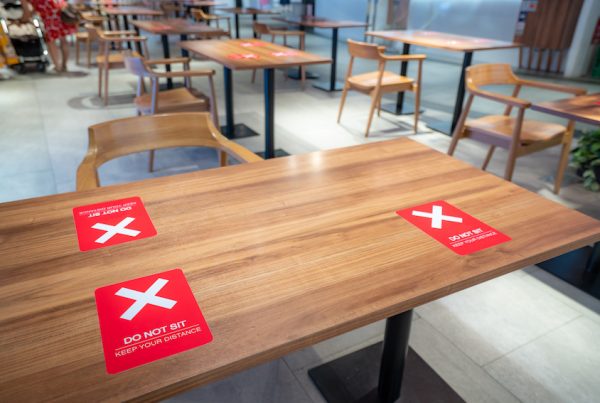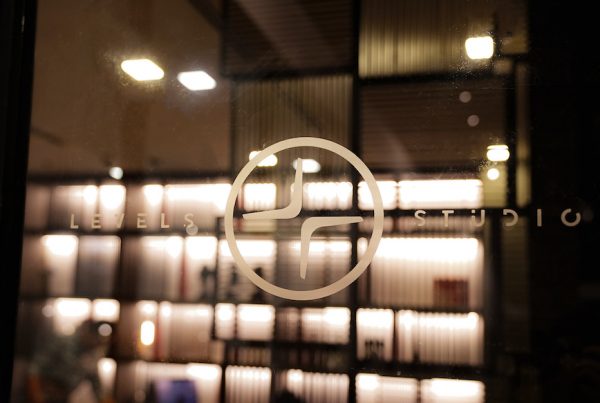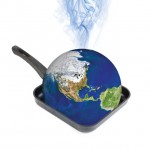
Our Pursuit of taste & earth heats up?
Pare it down to “convenience” or elevate it to “experience”, the culture of dining out has never seen so much growth than now. The abundance of eateries of all range, size and concept are capturing the hearts of discerning diners as well as the everyday person looking to fulfill his need for nourishment. It’s a steady rise and the National Restaurant Association (NRA) projected that the restaurant-and- foodservice sales reaching up to USD660.5 billion in 2013¹. A staggering and record figure. And it also noted that American restaurant operators continue to look beyond by expanding to the Asian, European, South America and African continents1. This is just in America, we certainly must not discount the growth spurts all around the world.
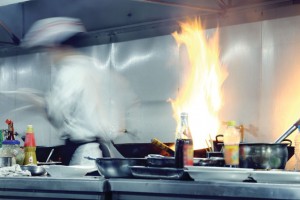
Exhaust systems trap smoke but consumes much energy
Much as we enjoy each morsel of food, the F & B industry is one of the biggest contributors to food wastage. In a nutshell, food that end up in the bin ends up in landfills together with other organic materials, eventually generating methane that traps heat in the atmosphere, hence the global warming phenomenon2. Even our source of life is becoming scarce and it is eye-opening to note that disposing 1kg of beef wastes 50,000 litres of water used to produce that meat². While there
is yet to be deeply researched data on how food wastage hampers the environment, these examples ought to make restaurateurs sit up and play their role in preserving Nature through their passionate endeavour.

Smoke that becomes part of the many air pollutants
A greater concern for players in the industry would be the energy consumption aspect. Restaurants have been found to consume up to 3 times more energy than an average commercial building. The majority of restaurants open long hours, use specialised equipments, operate continuous food preparation as well as require very acute heating, ventilation and cooling levels to keep produce and the working environment in optimum condition. Because the F&B industry is unlikely to hit stagnancy, it is even more important to be environmentally conscious, not only to improve our living conditions but to lower a restaurant’s utility bills, resulting in better cost efficiency. Interestingly, being eco- conscious can also improve productivity as energy-efficient equipments reduce heat levels while green cleaning supplies are devoid of hazardous chemicals. Even your customers are becoming more aware of the ecosystem’s health with 62% of diners polled in 2008’s National Restaurant Association survey preferring to dine at an environmentally friendly joint³.
¹ National Restaurant Association – 2013 Restaurant Industry Forecast
² http://www.lovefoodhatewaste.nsw.gov.au/love-food/environmental-impacts.aspx
³ http://www.foodservicewarehouse.com/restaurant-equipment-supply-marketing-articles/going-green/why-go-green-in-the-commercial-kitchen/c28100.aspx

Traditional and nostalgic but not the prettiest sight
ECO-FRIENDLY RESTAURANT BEGINS FROM A GREEN KITCHEN
At which point is a kitchen green enough? Navigating this question may not be as clear cut, thus the formation of LEED® (Leadership in Energy and Environmental Design)⁴. Created by the United States Green Building Council (USGBC), this voluntary third party green certification program puts in place the benchmark for the design, instruction and operation of high performance green buildings. LEED® has been adopted as the “mark-to-reach” by various building developments in over 135 countries and counting. Using the LEED® Rating Systems, teams involved in the construction of any building have a guideline in making the right decisions for it to be effectively eco-friendly. The foodservice industry usually uses the LEED® for Commercial Interiors (LEED®-CI) and LEED® for Schools-New Construction/Major Renovation (LEED®-NC) Rating. Areas taken into account are Sustainable Sites, Energy and Atmosphere, Water Efficiency, Materials & Resources, Indoor Environmental Quality, Innovation In Design and Regional Priority.
LEED® certifies the building as a whole, not products that are used in constructing it or products used in operations. In view of this, what if your existing or future restaurant is not housed in a building built with LEED® certification in mind? It is a very likely scenario that many operators furnish existing shop lots into restaurants. This does not mean you are out of the running for a LEED® certification; the equipments you use can contribute to earning points for the certification. A minimum of 40 points earns the project Certified LEED® whilst Platinum is the highest ranking with a maximum 110 points.
⁴ LEED® data extracted from http://new.usgbc.org/leed

Conserve environment and save cost with energy efficient equipments
EQUIPPING FOR A GREEN FUTURE
Pardon the pun, though on a serious note, investing in equipments is probably a wiser move for the cost is definitely lower than constructing an entire new project to meet the LEED® guidelines. Besides, existing buildings must certainly not be left abandoned; that would mean poor utilising or resources that impact the environment even more. All the action in the kitchen makes up about 30% of a restaurant’s total energy bill with machines that perform various functions continuously. We spoke to David J. Kidney, consultant with renowned Romano Gatland Asia Pacific that specialises in designing commercial kitchens. His key points include:
[unordered_list style=”bullet”]
- How practical is it? For example, open fire cooking emitting lots of smoke into the air defeats the purpose
- Clean out the ventilation and exhaust system regularly to avoid dirt build-up
- Recycle and reuse when possible (heat recovery process to heat or boil water)
- Use Energy Star® rated equipments suitable to the kitchen’s capacity
[/unordered_list]
UNDERSTANDING ENERGY STAR®
Speaking about the above, this initiative is a voluntary program established by the U.S. Environmental Protection Agency (EPA) in 1992 with the purpose of helping businesses and individuals save money and protect the climate through superior energy efficiency. Further into it, it soughts to identify and promote energy-energy products and buildings that reduce energy consumption, improve energy security and reduce pollution. In the United States alone, energy use in homes, buildings and industries contribute 2/3 of greenhouse gas emissions so can we imagine the impact on the environment if we take data from the world into account? Today, more and more equipments are made to adhere to the ENERGY STAR® label that helps cut down greenhouse gas emissions5 as well as save energy and water. For a product to earn the label, it must meet this set of key guiding principles6:
[unordered_list style=”bullet”]
- Categories of products must contribute significant energy savings nationwide
- Deliver consumer-demanded features and performance, together with increased energy efficiency
- Ensuring purchasers recovery of their investment through utility bill savings in a considerable period even though buying the qualified equipment cost more than a less- efficient counterpart
- Achieve energy efficiency through broadly available technologies offered by more than one manufacturer
- Measurable energy consumption and performance of product through testing
- Labeling effectively differentiates products for purchasers’ visibility
[/unordered_list]
5 http://www.energystar.gov/index.cfm?c=about.ab_history
6 http://www.energystar.gov/index.cfm?c=products.pr_how_earn
Although equipments in your kitchen are ENERGY STAR® stamped, cutting down more on energy consumption is still possible with regular maintenance of machines like fridges, ovens, dishwashers, fryers. Dirty equipment work harder and run slower – unclean coils in a fridge uses about 23% more energy than a clean one7.

A heaty & smoky kitchen makes work hard
RETRO; THE NEW BUZZ IN ENERGY EFFICIENCY
The term “retrofitting” takes old equipment and fitting it with high-efficiency parts or accessories. This way, a restaurant operator can better plan out its investment plan for new equipments from savings gleaned from these smaller changes. Changing to LED bulbs cuts down lighting cost by as much as 90%, not to mention its safety to the environment by not containing mercury. Even fluorescent lightbulbs are more effective than incandescent typically used on overhead and appliance lightings. As refrigerators use plenty energy and is also one of the most pricey piece of equipment, get saving by installing door closers that prevent cold air from being wasted. Install display case covers to enable kitchen staff to see what’s inside the fridge instead of constantly opening to check. A display case can save up to 70% less energy compared to an open case.
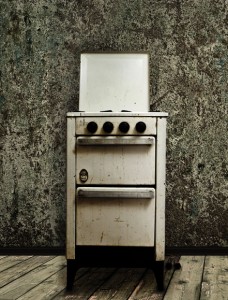
Regular cleaning up improves machines’ efficiency
SMALL BUT IMPORTANT ACTS
As one of the oldest industries of the world, F&B continues to thrive in modern times. Inevitably, progression hampers the health of the environment and operators worldwide are beginning to realise the difference they can make, beyond providing gastronomic experiences. Going green is more than revamping the entire kitchen with equipments and reconstructing although by not over sizing the exhaust system, the load on an air-conditioner can be reduced. Equally important are everyday acts that can make a difference. Too many kitchen crews walk away without ensuring that the taps are tightly shut and as water trickles from the numerous sinks, “going down the drain” speaks so true. The same goes for lights; make it a habit to go around the workspace to check that all lights are turned off before closing down daily. If you notice that plates of food regularly returning with wastage, it could be your portions are too large and you can consider shrinking to cut down on food waste. Good planning also can help reduce operating time of certain equipments, for example, maximising the capacity of a machine at each time of use. By being mindful and adopting an energy efficiency mindset, the industry can help ease the burden on Mother Earth.
More elaboration on how you can green your kitchen with equipments across all boards in the operations > ECO-FRIENDLY commercial kitchen through equipment







